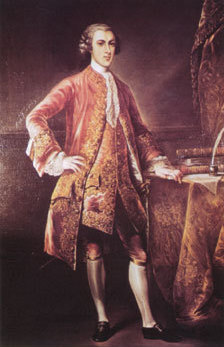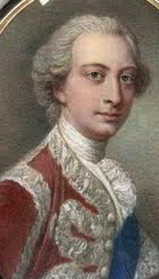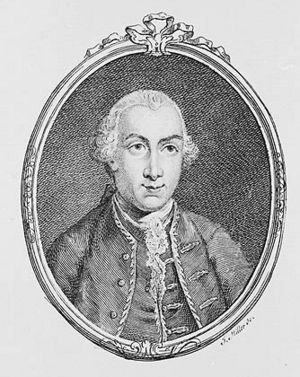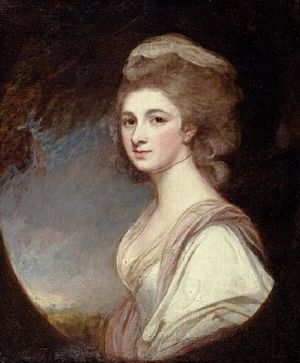Frederick Calvert, 6th Baron Baltimore facts for kids
Quick facts for kids
The Lord Baltimore
|
|
|---|---|
 |
|
| Born | 6 February 1731 |
| Died | 4 September 1771 (aged 40) Naples, Italy
|
| Spouse(s) |
Lady Diana Egerton
(m. 1753) |
| Children | Henry Harford (1758–1834) Francis Mary Harford (1759–1822) Sophia Hales (born c.1765) Elizabeth Hales (born c.1765) Charlotte Hope, born 1770 |
| Parent(s) | Charles Calvert, 5th Baron Baltimore Mary Janssen |
Frederick Calvert, 6th Baron Baltimore (born February 6, 1731 – died September 4, 1771) was an English nobleman. He was the last person to hold the title of Baron Baltimore. Even though he had great power in the Province of Maryland, he never visited the colony. Unlike his father, he wasn't very interested in politics. He mostly saw his lands, including Maryland, as a way to get money for his expensive and often talked-about lifestyle. He faced a lot of criticism and had poor health. He died from a fever in Naples when he was 40 years old.
Contents
Early Life of Frederick Calvert
Frederick Calvert was born in 1731. He was the oldest son of Charles Calvert, 5th Baron Baltimore. His father was the 3rd Proprietor Governor of Maryland. Frederick was named after his godfather, Frederick, Prince of Wales. This prince was the oldest son of King George II. He was also the father of King George III. Young Frederick went to Eton College for his education. There, he became good at studying classic subjects. Frederick also had two sisters, Caroline and Louisa Calvert.
Becoming Lord Baltimore
In 1751, Frederick's father, Charles Calvert, passed away. Frederick was only 20 years old. He inherited the title Baron Baltimore from his father. He also became the Proprietary Governor of the Province of Maryland. This made him a very rich nobleman in England. He also became a powerful leader in America. Maryland was a British colony at that time. The Calvert family directly managed it.
Frederick received a huge income from taxes and rents. It was about £10,000 a month, which was a massive amount of money back then. He also owned shares in the Bank of England. Plus, he had a large estate called Woodcote Park in Surrey, England.
Maryland Colony Affairs
When Calvert inherited Maryland, people in the colony were becoming unhappy. The local assembly wanted to end his family's strict rule. However, Calvert didn't care much about the colony. He never even visited it, unlike the leaders before him. He preferred to live in England and travel in Europe. He spent time in Italy and even in Constantinople. He had to leave Constantinople after some accusations about his unusual living arrangements.
Calvert enjoyed a life of luxury. He wrote poems and saw Maryland mainly as a source of money. During the 1750s, the French and Indian War was happening. Money was needed to protect the colonies. Maryland was the only colony that refused to pay its share. Calvert would only agree to raise taxes if his own large estates were not taxed. Benjamin Franklin later wrote that Maryland's government, not its people, was at fault.
The colony was run by governors chosen by Calvert. These included Horatio Sharpe and later Robert Eden. Governor Sharpe knew how hard things were for the people because of Lord Baltimore's stubbornness. But he couldn't do much. Calvert also oversaw the end of a long argument about the border between Maryland and Pennsylvania. This was called the Penn–Calvert Boundary Dispute.
Frederick's Marriage
On March 9, 1753, Frederick married Lady Diana Egerton. She was the youngest daughter of Scroop Egerton, 1st Duke of Bridgewater. Their marriage was not successful. They spent most of their time apart. They did not have any children. In May 1756, they officially separated because they couldn't get along.
Travels in Europe
Frederick Calvert became known for his unusual way of life. In 1764, James Boswell started his Grand Tour of Europe. He had heard that Baltimore was "living at Constantinople like a Turk." Boswell also noted that Baltimore "lived luxuriously" and "was constantly taking medicines." He thought Baltimore was living a "strange, wild life" that wasn't helpful to his country.
Calvert spent a lot of time in Italy. The German art historian Johann Joachim Winckelmann described him as someone who had lost all interest in things. Calvert was so fascinated by the Ottoman Turks that in 1766, he changed part of his London house. He rebuilt it to look like a Turkish-style home.
In 1767, Calvert published a book about his travels. It was called A tour to the East, in the years 1763 and 1764. It included his thoughts on Constantinople and the Turks. It also had some Eastern jokes, poems, and wise sayings. Horace Walpole said the book wasn't worth publishing. He added that it showed how someone could travel without noticing anything and write without ideas.
Calvert spent a huge amount of money. He spent a lot on his family estate at Woodcote Park. According to Walpole, Calvert made the inside of the house look "flashy" and "silly" in the "French" style.
Family and Children
Frederick Calvert had several children with different women, outside of marriage. He did try to support them.
He had two children with Hester Whelan:
- Henry Harford (1758–1835), who became the last Lord Proprietor of Maryland.
- Frances Mary Harford (1759–1822). She married William Frederick Wyndham in 1784. Their son, George Wyndham, later became the 4th Earl of Egremont.
In 1765, he had twin daughters, Sophia and Elizabeth Hales, with Elizabeth Dawson. She was from Lincolnshire.
He also had another daughter, Charlotte Hope. She was born in Hamburg in 1770. Her mother was Elizabeth Hope from Münster, Germany.
Maryland and the American Revolution
In his will, Calvert left his land in Maryland to his oldest son, Henry Harford. Henry was only 13 years old at the time. This decision went against his family's wishes. However, Calvert did leave money to his sisters. He left £20,000 to be shared between Louisa and Caroline.
The colony of Maryland seemed happy to be free of Frederick. They accepted Henry Harford as Calvert's heir. But Calvert's sister, Louisa Calvert Browning, challenged the will. She did not agree with Henry's inheritance. Before the court case could finish, things changed in America forever.
Sadly for young Henry, by the time he grew up, Maryland was part of the American Revolution. By 1776, it was fighting against Britain. Henry Harford eventually lost almost all his lands in the colonies. But he remained rich because of his large inheritance in Great Britain.
Reputation and Legacy
Frederick Calvert was not well-liked by people who lived at the same time as him. One person described him as "weak in body, vain, silly, and wild, but also kind and caring." Another called him a "bad and wild person." People who came after him have also not been very kind to his memory.
Some people say that Frederick County, Maryland, was named after the last Baron Baltimore. But this has not been proven. The official flag of the State of Maryland is special among the 50 states. It shows the history of his family's legacy.
Published Works
- A tour to the East, in the years 1763 and 1764: with Remarks on the City of Constantinople and the Turks. Also Select Pieces of Oriental Wit, Poetry and Wisdom, London (1767).
- Gaudia poetica Latina, Anglica, et Gallica Lingua Composita, London (1770).
See also
- Baron Baltimore
- History of Maryland in the American Revolution
- Province of Maryland
Arms
|







